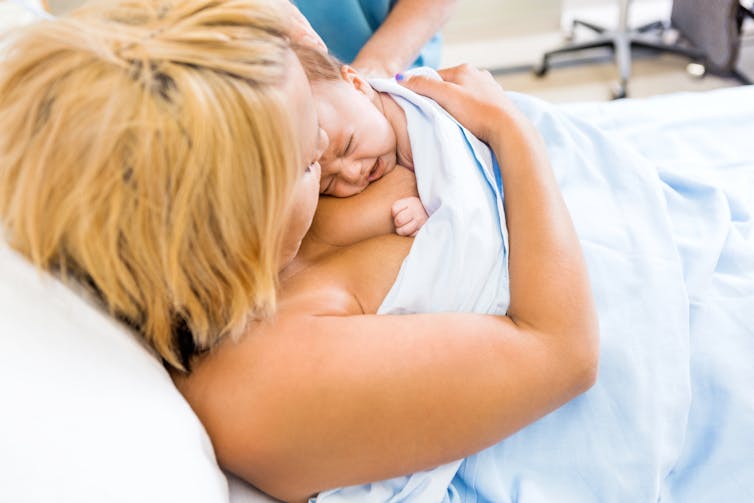, and ,
All babies undergo painful procedures, including injections of medications, and . These procedures occur shortly after birth, during the first few days after birth and throughout a baby’s first year.
Thanks to over two decades of research, we know that there are highly effective strategies to help reduce babies’ pain when they have to undergo painful procedures: Breastfeeding and parent-infant skin-to-skin contact.
These strategies are safe, accessible, supported by science and recommended by organizations such as the for minimizing pain in infants up to 12 months old. They are also parent-led — meaning that parents are the source of comfort for their newborns.
However, despite the pain-reducing benefit of using these strategies, they are not always used to manage infant pain. In fact, studies show that during routine medical procedures. In addition to causing unnecessary suffering, unmanaged pain in early life is associated with negative consequences, such as feeling .
As nurse scientists and experts in infant pain management, we want to highlight key tips and tricks to help you use these parent-led strategies (as well as a few additional ways to reduce your baby’s pain) during their next painful procedure.
1. Breastfeeding
for full-term infants undergoing procedures, such as injections and blood draws, in the first year of life. Breastfeeding babies have lower pain responses, including less crying, less change in their heart rate and lower scores on tools developed to measure infant pain. Consider the following when using breastfeeding as a pain-management strategy for your infant:
Ìý

• Work with your health-care provider to find a place where you can comfortably breastfeed your baby while they complete the procedure. As a breastfeeding parent, you are the expert in feeding your baby! There is no recommended breastfeeding positioning that is best for pain management — simply what works best for you and your baby to achieve an optimal latch so your baby is able to suck effectively. It is also important that the health-care provider is able to conduct the procedure.
• Ideally, you want to breastfeed your baby for a minimum of two minutes prior to the painful procedure. They should be latched to the breast and actively sucking and swallowing before the painful procedure. Don’t worry, breastfeeding during procedures is safe! There are no reports of baby’s choking while breastfeeding during procedures.
• Continue breastfeeding your baby throughout the painful procedure and for as long as your baby wants to breastfeed afterwards.
2. Skin-to-skin contact
Skin-to-skin contact, also sometimes called kangaroo care, involves holding a baby wearing only a diaper against your bare chest. Studies show that babies who are in during the painful procedure and they recover faster — meaning that if they do experience some pain or distress, it is for less time than if they were not in skin-to-skin contact. While breastfeeding is the best treatment for full-term babies, skin-to-skin contact is recommended for babies who are born prematurely or infants unable to breastfeed.
Using skin-to-skin contact for pain relief is simple and easy. Follow these steps:
• Work with your health-care provider to find a comfortable place to sit, where you can cuddle your baby for 10-15 minutes.
• Undress your baby so they are wearing only a diaper and hold them facing inward with their chest against your bare chest. You can use a blanket over you both for comfort, warmth and privacy.
• Hold your baby in skin-to-skin contact for at least 10 minutes before the painful procedure — up to 15 minutes is ideal. Your baby should be calm and relaxed before the procedure is done.
• Keep your baby in skin-to-skin contact during the procedure and afterwards to help them stay calm and relaxed.
Ìý

Research shows that infants who are in . Fathers, adoptive parents, co-parents and other family members such as grandparents can also provide skin-to-skin contact to help reduce pain during procedures.
3. Additional ways to reduce your baby’s pain
If you are not breastfeeding your baby or cuddling your baby in skin-to-skin contact, having them suck on a pacifier or your clean finger during the procedure can reduce their pain as well. You can also use a sweet tasting solution, such as a , prior to the procedure or add a about an hour before the procedure to help numb the skin where a needle is to be injected.
Always remember to keep your baby . Babies become more distressed if they are lying flat during injections or procedures.
Many parents do not realize what an important role they can play in reducing their baby’s pain during routine needles and pricks. and science shows they can provide the ideal pain management and comfort during procedures. Parents also know their baby best, so are in the best position to advocate for the use of strategies that work for managing their baby’s pain.
Talking with your health-care provider about using these pain management strategies for your baby’s next painful procedure will help ensure that they are used. is also a great resource for up-to-date and evidence-based information on pain in children to help give you the knowledge you need to manage your baby’s pain well.
This story is part of a series produced by , a national knowledge mobilization network whose mission is to improve children’s pain management by mobilizing evidence-based solutions through co-ordination and collaboration.![]()
, Assistant Professor of Nursing and Health Sciences Research Chair, and , Professor, School of Nursing,
This article is republished from under a Creative Commons license. Read the .

